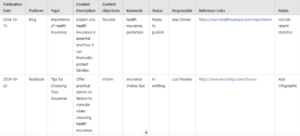In the health insurance field, effective communication with clients is not just good practice; it’s essential. With the constant evolution of digital tools, agents and agencies have innovative methods at their disposal to enhance their content strategies. One such method is the use of ChatGPT, an advanced language model that can revolutionize how you generate and plan your content. In this blog, we’ll guide you through the steps to create a content grid using ChatGPT, ensuring your communications are both strategic and effective.
Introduction to ChatGPT
ChatGPT is an artificial intelligence tool developed by OpenAI that can generate coherent and contextually relevant text. For health insurance professionals, this means the ability to create high-quality content that is tailored to meet the specific needs of their audience. ChatGPT can assist in creating a variety of content formats, from blog posts to emails and social media posts.
Step 1: Defining Content Objectives
Before you begin generating any content, it’s crucial to have a clear understanding of your goals. Do you want to educate your clients about the benefits of new policies? Or perhaps inform them about recent changes in health legislation? Establishing clear objectives will help keep your content focused and relevant.
Step 2: Knowing Your Audience
The next step is to deeply understand your audience. Knowing the preferences, needs, and behaviors of your clients will allow you to segment your audience and customize the content. This not only increases the relevance of the message but also enhances the effectiveness of your communication.
Step 3: Creating a Content Grid
Use a content calendar to plan and organize your marketing activities. This calendar should include key dates, topics, formats, and platforms where the content will be published. Next, you can use ChatGPT to generate drafts for each content piece, providing the tool with specific details about the tone and key points that need to be covered.

Step 4: Production and Customization of Content
Although ChatGPT is a powerful tool, it is always crucial to review and personalize the content it generates. Make sure the content reflects your brand’s voice and is appropriate for your audience, especially when dealing with sensitive topics like health.
Step 5: Optimization and Publication
Before publishing, optimize your content for different platforms. For example, what works on LinkedIn may not be suitable for Instagram or Facebook. Also, ensure that each piece of content includes a clear call to action, guiding readers on what they should do next.
Use of Visual Tools
Visual content plays a crucial role in capturing and retaining user attention. Integrate visual elements such as images and videos to make the content more engaging and easier to consume. Tools like Canva can be helpful in creating visually appealing graphics and images that complement your text.
Evaluation and Adjustment
Finally, it’s vital to evaluate the performance of your content using metrics such as open rates, clicks, and conversions. This data will help you understand which aspects of your content grid work well and which need adjustments.
Creating a content grid with the help of ChatGPT can transform how you communicate with your clients in the health insurance sector. By leveraging this technology, you can ensure that your content is not only relevant and timely but also engaging and effective. This will allow you to build stronger and more enduring relationships with your clients, enhancing not only your brand’s perception but also your business outcomes.

